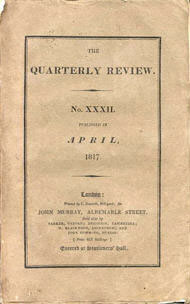Quarterly Review
 | |
| First issue | March 1809 |
|---|---|
| Final issue | 1967 |
| Company | John Murray II |
| Country | United Kingdom |
| Language | English |
The Quarterly Review was a literary and political periodical founded in March 1809[1] by London publishing house John Murray. It ceased publication in 1967. It was referred to as The London Quarterly Review, as reprinted by Leonard Scott, for an American edition.[2]
Early years
Initially, the Quarterly was set up primarily to counter the influence on public opinion of the Edinburgh Review. Its first editor, William Gifford, was appointed by George Canning, at the time Foreign Secretary, later Prime Minister.
Early contributors included Secretaries of the Admiralty
Under Gifford, the journal took the Canningite liberal-conservative position on matters of domestic and foreign policy, if only inconsistently.[3] It opposed major political reforms, but it supported the gradual abolition of slavery, moderate law reform, humanitarian treatment of criminals and the insane, and the liberalizing of trade. In a series of articles in its pages, Southey advocated a progressive philosophy of social reform. Because two of his key writers, Scott and Southey, were opposed to Catholic emancipation, Gifford did not permit the journal to take a clear position on that issue.
Reflecting divisions in the Conservative party itself, under its third editor, John Gibson Lockhart, the Quarterly became less consistent in its political philosophy. While Croker continued to represent the Canningites and Peelites, the party's liberal wing, it also found a place for the more extremely conservative views of Lords Eldon and Wellington.
During its early years, reviews of new works were sometimes remarkably long. That of Henry Koster's Travels in Brazil (1816) ran to forty-three pages.[4]
Controversial reviews
Typical of early nineteenth-century journals, reviewing in the Quarterly was highly politicized and on occasion excessively dismissive. Writers and publishers known for their Unitarian or radical views were among the early journal's main targets. Prominent victims of scathing reviews included Irish novelist
In an 1817 article, John Wilson Croker attacked
In 1816,
Nineteenth-century editors
- William Gifford (February 1809 – December 1824. Vol. 1, Number 1 – Vol. 31, Number 61)
- John Taylor Coleridge (March 1825 – December 1825. Vol. 31, Number 62 – Vol. 33, Number 65)
- John Gibson Lockhart (March 1826 – June 1853. Vol. 33, Number 66 – Vol. 93, Number 185)
- Whitwell Elwin (September 1853 – July 1860. Vol. 93, Number 186 – Vol. 108, Number 215)
- William Macpherson (October 1860 – January 1867. Vol. 108, Number 216 – Vol. 122, Number 243)
- William Smith (April 1867 – July 1893, Vol. 122, Number 244 – Vol. 177, Number 353)
- John Murray IV (October 1893 – January 1894. Vol. 177, Number 354 – Vol. 178, Number 355)
- Rowland Edmund Prothero(April 1894 – January 1899. Vol. 178, Number 356 – Vol. 189, Number 377)
- George Walter Prothero (April 1899 – October 1900. Vol. 189, Number 378 – Vol. 192, Number 384)[5]
References
- ^ Courier (London newspaper), March 1, 1809, "Published this day". The first issue, however, bore a title page date of February, 1809.
- archive.org
- ^ Boyd Hilton, '“Sardonic grins” and “paranoid politics”: Religion, Economics, and Public Policy in the Quarterly Review’, in J. Cutmore (ed.), Conservatism and the Quarterly Review: A Critical Analysis (London: Pickering & Chatto, 2007), pp. 41-60.
- ^ 'Art. IV. Travels in Brazil By Henry Koster', review in Quarterly Review dated January 1817, in bound volume XVI (London: John Murray, 1817), pp. 344–387
- ^ Walter E. Houghton (ed.), The Wellesley Index to Victorian Periodicals 1824–1900, 5 vols. (Toronto: Univ. of Toronto Press, 1966–87), Vol. 1.
Further reading
- Jonathan Cutmore (ed.), Conservatism and the Quarterly Review: A Critical Analysis (London: Pickering & Chatto, 2007)
- Jonathan Cutmore, Contributors to the Quarterly Review 1809-25: A History (London: Pickering & Chatto, 2008)
- John O. Hayden, The Romantic Reviewers, 1802-1824 (Chicago: UCP, 1969)
- Joanne Shattock, Politics and Reviewers: The Edinburgh and the Quarterly in the Early Victorian Age (Leicester: Leicester University Press, 1989)
- Hill Shine and Helen Chadwick Shine, The Quarterly Review Under Gifford: Identification of Contributors 1809-1824 (Chapel Hill: University of North Carolina Press, 1949) [Shine is superseded by Cutmore, Contributors (2008)]
- The main repository of manuscript papers relating to the Quarterly Review is the John Murray Archive, a collection of manuscripts related to the John Murray publishing house. In 2007, the archive was purchased by the National Library of Scotland, Edinburgh.
External links
- The Quarterly Review Archive at Romantic Circles by University of Colorado Boulder
- The Quarterly Review at Internet Archive
![]() This article incorporates text from a publication now in the public domain: Wood, James, ed. (1907). "Quarterly Review". The Nuttall Encyclopædia. London and New York: Frederick Warne.
This article incorporates text from a publication now in the public domain: Wood, James, ed. (1907). "Quarterly Review". The Nuttall Encyclopædia. London and New York: Frederick Warne.
